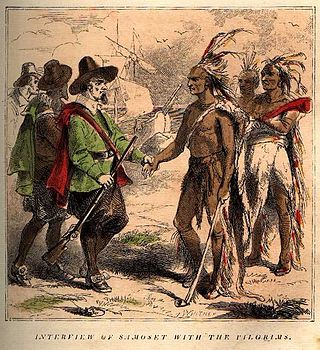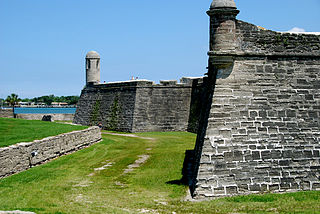
The Thirteen Colonies were a group of British colonies on the Atlantic coast of North America during the 17th and 18th centuries. Grievances against the imperial government led the 13 colonies to begin uniting in 1774, and expelling British officials by 1775. Assembled at the Second Continental Congress in Philadelphia, they appointed George Washington as commander-in-chief of the Continental Army to fight the American Revolutionary War. In 1776, Congress adopted the Declaration of Independence as the United States of America. Defeating British armies with French help, the Thirteen Colonies gained sovereignty with the Treaty of Paris in 1783.

The War of Jenkins' Ear was a conflict lasting from 1739 to 1748 between Britain and Spain. The majority of the fighting took place in New Granada and the Caribbean Sea, with major operations largely ended by 1742. It was related to the 1740 to 1748 War of the Austrian Succession. The name was coined in 1858 by British historian Thomas Carlyle, and refers to Robert Jenkins, captain of the British brig Rebecca, whose ear was allegedly severed by Spanish coast guards while searching his ship for contraband in April 1731.

Darien is a city in and the county seat of McIntosh County, Georgia, United States. It lies on Georgia's coast at the mouth of the Altamaha River, approximately 50 miles south of Savannah, and is part of the Brunswick, Georgia metropolitan statistical area. It is the second-oldest planned city in Georgia and was originally called New Inverness. The population of Darien was 1,460 at the 2020 census, down from 1,975 in 2010.

The institution of slavery in the European colonies in North America, which eventually became part of the United States of America, developed due to a combination of factors. Primarily, the labor demands for establishing and maintaining European colonies resulted in the Atlantic slave trade. Slavery existed in every European colony in the Americas during the early modern period, and both Africans and indigenous peoples were targets of enslavement by European colonists during the era.

The colonial history of the United States covers the period of European colonization of North America from the early 16th century until the incorporation of the Thirteen Colonies into the United States in 1776 during the Revolutionary War. In the late 16th century, England, France, Spain, and the Dutch Republic launched major colonization expeditions in North America. The death rate was very high among early immigrants, and some early attempts disappeared altogether, such as the English Lost Colony of Roanoke. Nevertheless, successful colonies were established within several decades.

The Province of Georgia was one of the Southern Colonies in colonial-era British America. In 1775 it was the last of the Thirteen Colonies to support the American Revolution.

The Battle of Bloody Marsh took place on 7 July 1742 between Spanish and British forces on St. Simons Island, part of the Province of Georgia, resulting in a victory for the British. Part of the War of Jenkins' Ear, the battle was for the British fortifications of Fort Frederica and Fort St. Simons, with the strategic goal the sea routes and inland waters they controlled. With the victory, the Province of Georgia established undisputed claim to the island. The British also won the Battle of Gully Hole Creek, which took place on the island the same day.

The colonial period of South Carolina saw the exploration and colonization of the region by European colonists during the early modern period, eventually resulting in the establishment of the Province of Carolina by English settlers in 1663, which was then divided to create the Province of South Carolina in 1710. European settlement in the region of modern-day South Carolina began on a large scale after 1651, when frontiersmen from the English colony of Virginia began to settle in the northern half of the region, while the southern half saw the immigration of plantation owners from Barbados, who established slave plantations which cultivated cash crops such as tobacco, cotton, rice and indigo.
The Yamasee War was a conflict fought in South Carolina from 1715 to 1717 between British settlers from the Province of Carolina and the Yamasee, who were supported by a number of allied Native American peoples, including the Muscogee, Cherokee, Catawba, Apalachee, Apalachicola, Yuchi, Savannah River Shawnee, Congaree, Waxhaw, Pee Dee, Cape Fear, Cheraw, and others. Some of the Native American groups played a minor role, while others launched attacks throughout South Carolina in an attempt to destroy the colony.

The siege of St. Augustine was a military engagement that took place during June–July 1740. It involved a British attack on the city of St. Augustine in Spanish Florida and was a part of the much larger conflict known as the War of Jenkins' Ear.
During the British colonization of North America, the Thirteen Colonies provided England with an outlet for surplus population as well as a new market. The colonies exported naval stores, fur, lumber and tobacco to Britain, and food for the British sugar plantations in the Caribbean. The culture of the Southern and Chesapeake Colonies was different from that of the Northern and Middle Colonies and from that of their common origin in the Kingdom of Great Britain.

The history of Charleston, South Carolina, is one of the longest and most diverse of any community in the United States, spanning hundreds of years of physical settlement beginning in 1670. Charleston was one of leading cities in the South from the colonial era to the Civil War in the 1860s. The city grew wealthy through the export of rice and, later, sea island cotton and it was the base for many wealthy merchants and landowners. Charleston was the capital of American slavery.

Lachlan McIntosh was a Scottish American military and political leader during the American Revolution and the early United States. In a 1777 duel, he fatally shot Button Gwinnett, a signer of the Declaration of Independence ten months earlier.

William Bull was a colonial American landowner and politician in the Province of South Carolina.

Lieutenant-General James Edward Oglethorpe was a British Army officer, Tory politician and colonial administrator best known for founding the Province of Georgia in British North America. As a social reformer, he hoped to resettle Britain's "worthy poor" in the New World, initially focusing on those in debtors' prisons.
The Georgia Experiment was the colonial-era policy prohibiting the ownership of slaves in the Georgia Colony. At the urging of Georgia's proprietor, General James Oglethorpe, and his fellow colonial trustees, the British Parliament formally codified prohibition in 1735, three years after the colony's founding. The ban remained in effect until 1751, when the diminution of the Spanish threat and economic pressure from Georgia's emergent planter class forced Parliament to reverse itself.

Native Americans living in the American Southeast were enslaved through warfare and purchased by European colonists in North America throughout the 17th, 18th, and 19th centuries, as well as held in captivity through Spanish-organized forced labor systems in Florida. Emerging British colonies in Virginia, Carolina, and Georgia imported Native Americans and incorporated them into chattel slavery systems, where they intermixed with slaves of African descent, who would eventually come to outnumber them. The settlers' demand for slaves affected communities as far west as present-day Illinois and the Mississippi River and as far south as the Gulf Coast. European settlers exported tens of thousands of enslaved Native Americans outside the region to New England and the Caribbean.

Fort San Francisco de Pupo was an 18th-century Spanish fort on the west bank of the St. Johns River in Florida, about eighteen miles from St. Augustine, the capital of Spanish Florida. Lying on the old trail to the Spanish province of Apalachee in western Florida, Fort Pupo and its sister outpost, Fort Picolata on the opposite shore of the river, controlled all traffic on the ferry crossing. The remains of Fort Pupo are situated about three miles south of Green Cove Springs in Clay County, near the end of Bayard Point opposite Picolata. The surrounding area is a hammock of southern live oak, southern magnolia, pignut hickory and other typical trees native to the region.

The Brunswick Town raid was an attack on Brunswick Town, North Carolina, conducted by Spanish privateers between September 3 and 6, 1748, during the War of Jenkins' Ear. The raiders were eventually driven off, which resulted in the destruction of one of their vessels. It was the final engagement of the war and resulted in a British victory.














